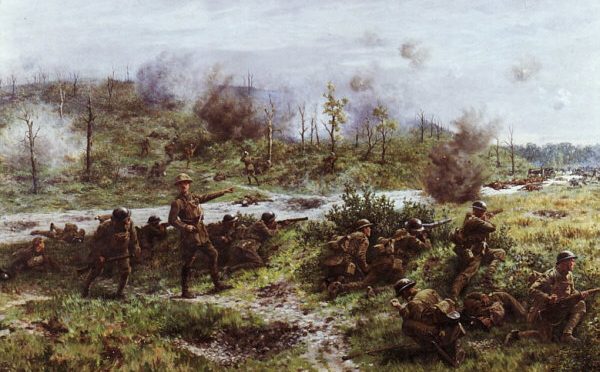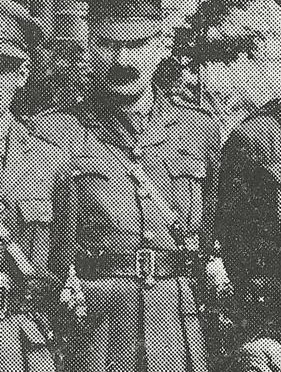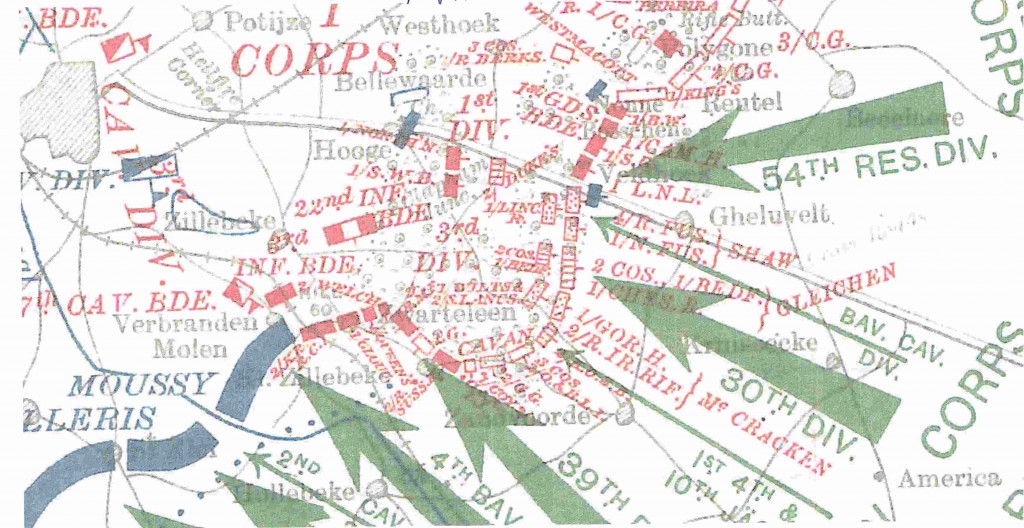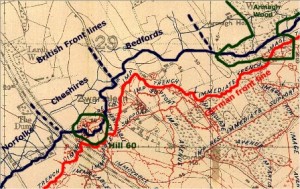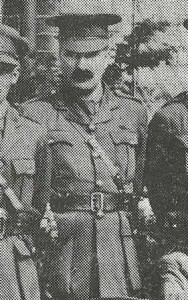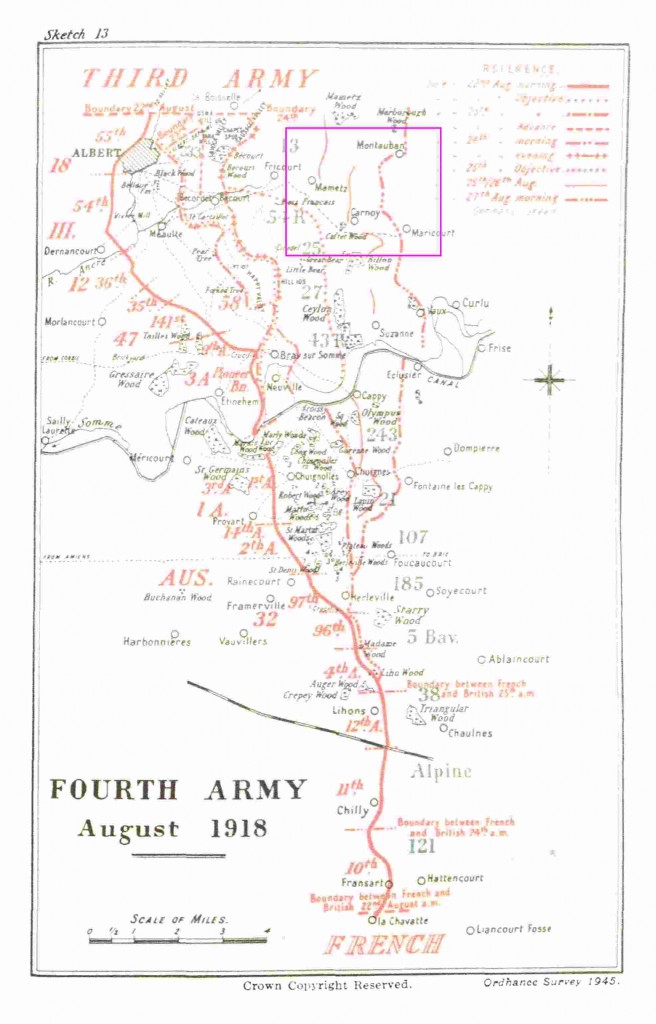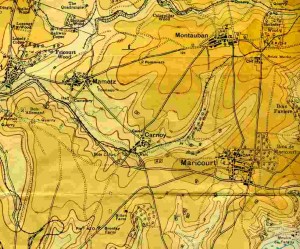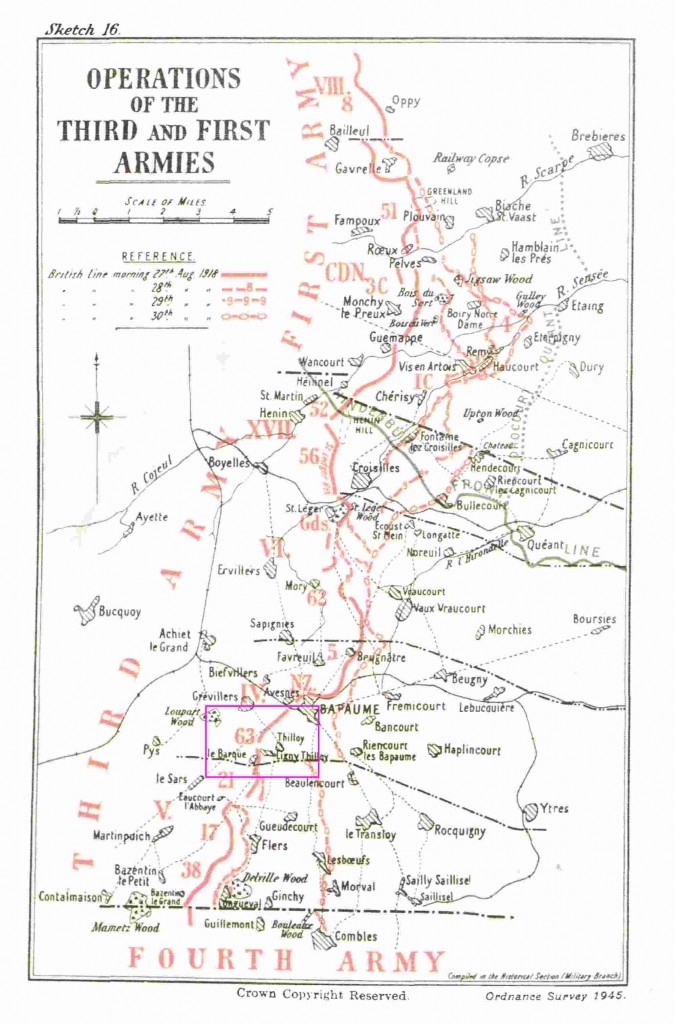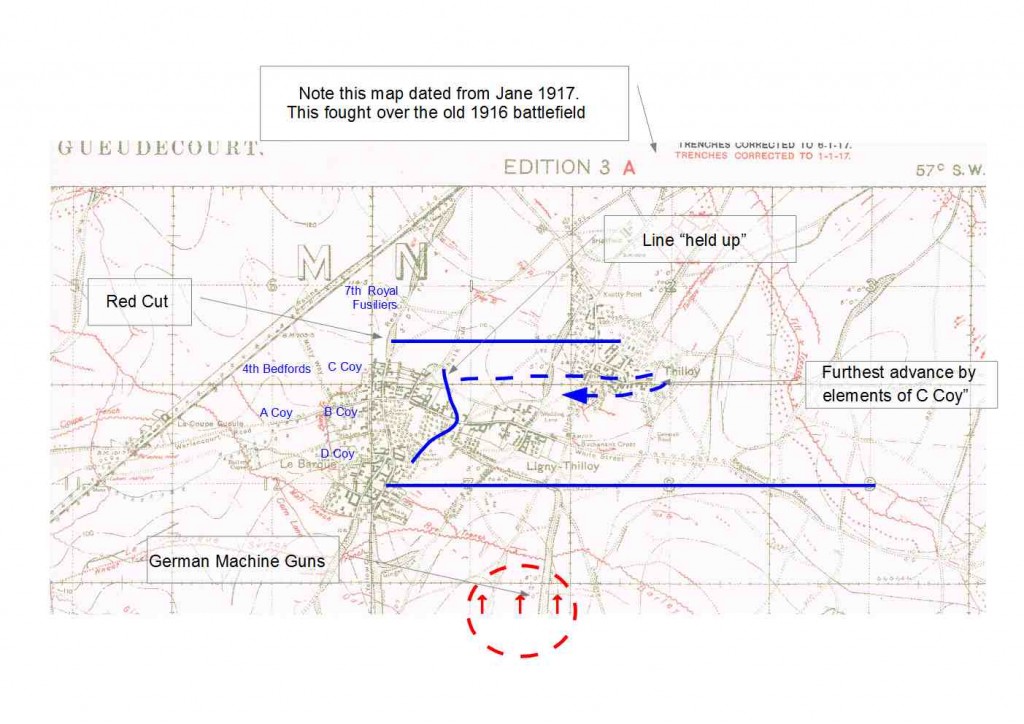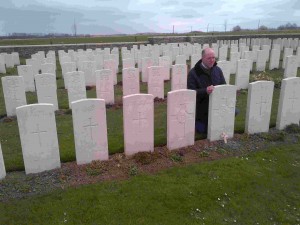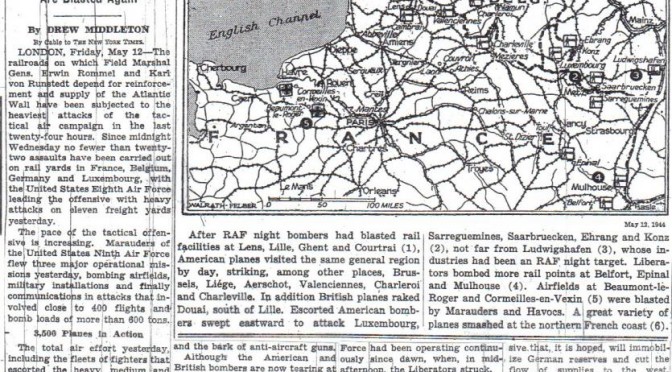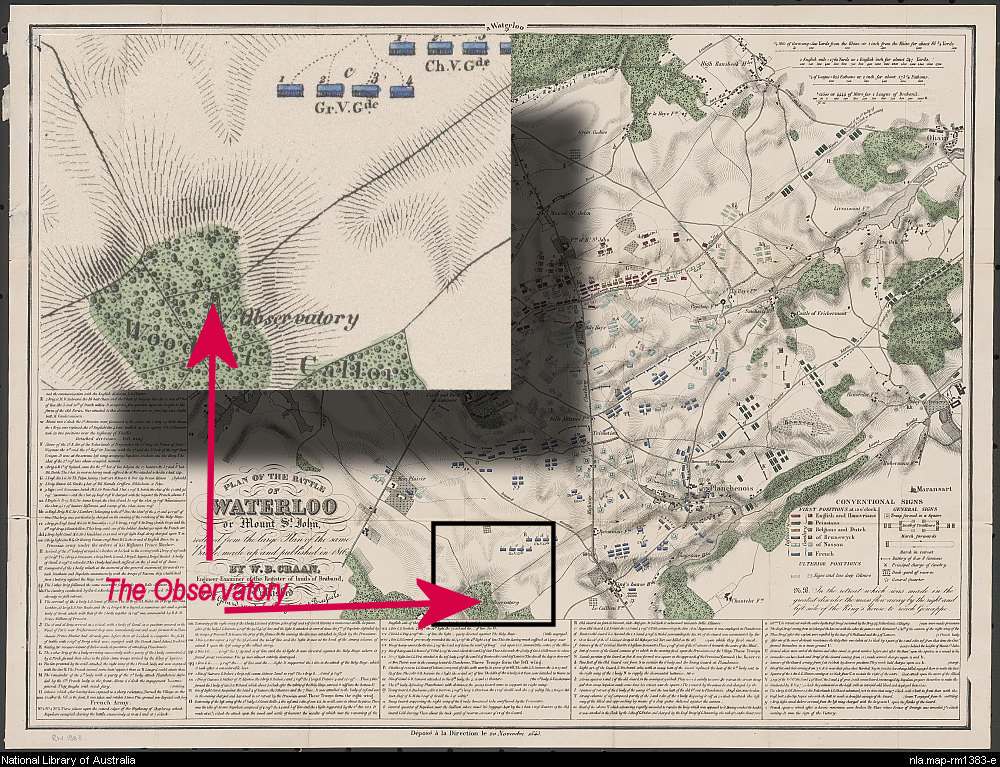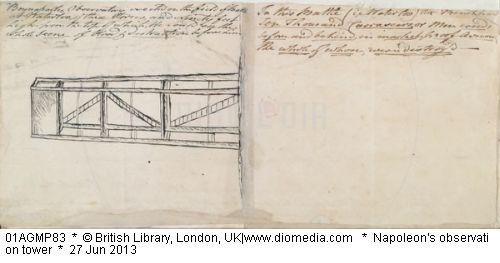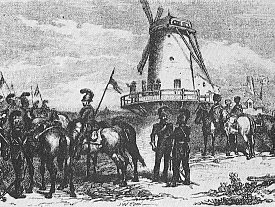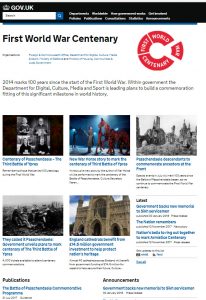
The main focus for commemoration in 2018 will be the centenary of the Armistice on 11th November. If you take your history from Blackadder, Sebastian Faulks, or even the Royal British Legion or Commonwealth War Graves Commission, you might be forgiven for thinking that Passchendale was the climax of the First World War and that the fighting ended in the vicinity of the same lines of trenches fought over since the end of 1914.
What do the official commemorative websites say happened in 1918?
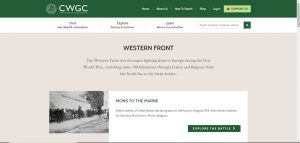
As of 2 February 2018, the Commonwealth War Grave Commission lacks any pages for 1918 in the Western Front campaign pages, which end at Cambrai. Nor does the British Government First World War Commemoration website make any reference to any events of 1918 before the Armistice. The Royal British Legion seems to have lost interest in the Centenary too. It’s focus for the year is to celebrate the 90th anniversary of its own Great Pilgrimage in Ieper, a location peripheral to the events of 1918. It offers a “100 days” option, alongside one to visit the battlefields of 1914-17, suggesting Loos and Mons as destinations. It looks self indulgent, if not neglectful for the Royal British Legion, as custodians of national Remembrance to organise an event celebrating 90 years of battlefield pilgrimages at a peripheral location that competes with the commemoration of the anniversary of the battle of Amiens.
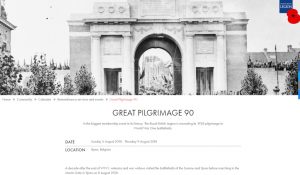
If you want to see the impact of official amnesia of 1918, read the coverage of centenary events in the media. The printed The Times report of the centenary of the sinking of the SS Tuscania on 5th February, in with the loss of over 200 American servicemen merely as “shortly before the end of the First World War.” This misses the point that the Americans men were on their way to fight the decisive battle. T he Daily Mail use the same language in their coverage of the airmen who wore slippers to face von Richthofen. The implication is that the war of 1918 is more of the same old trenches until November, and ignores entirely the intense air war that would kill von Richtofen and many of the other leading aces in the meantime.
1918 – the year that Challenges Preconceptions
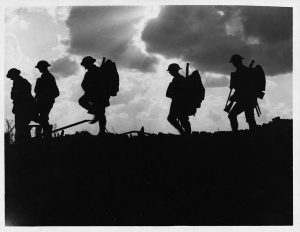
But this overlooks the dramatic events of 1918 itself. These do not sit comfortably with the popular stereotype of the Western Front. And that is one reason why the events of that year and the actions of those who fought deserves special recognition
1918 wasn’t about waves of Tommies going over the top in a vain attempt to break through lines of trenches. Instead, the battles of 1918 started with the Germans on the attack. Nor was it a tale of mud, blood, barbed wire and trench foot. Much of the fighting took place in open country and some distance from the battle fields of Passchendaele and Loos. The year contained some of the lowest points in British military history – and some of the highest.
It’s a pity that the events of 1918 have not attracted more support from the institutions that have led the commemorations of the First World War. It is shameful for their events to be bundled together as merely the overture to the centenary of the Armistice.
1. The German Spring offensives were among the biggest and bloodiest battles in history
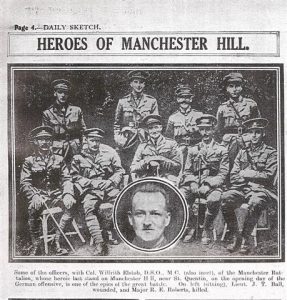 The Russian revolution and armistice ended Germans’s Eastern Front. For the first half of 1918, until the Americans arrived in force, the Germans would have superior numbers on the Western Front. Between March and May 1918 they stuck the British and then the French with a series of hammer blows. A combination of infiltration tactics, clever use of artillery and broke the stalemate of the trenches. These battles were the most intensely fought and bloodiest of the Western Front, if not in history. The casualties were very high.
The Russian revolution and armistice ended Germans’s Eastern Front. For the first half of 1918, until the Americans arrived in force, the Germans would have superior numbers on the Western Front. Between March and May 1918 they stuck the British and then the French with a series of hammer blows. A combination of infiltration tactics, clever use of artillery and broke the stalemate of the trenches. These battles were the most intensely fought and bloodiest of the Western Front, if not in history. The casualties were very high.
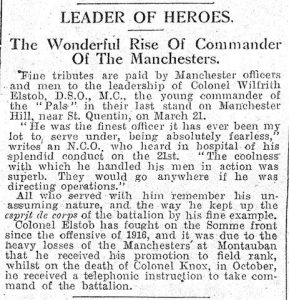 Between 21st March and 5th April the British Army lost 160,000 casualties, an average of over 10,000 casualties a day, compared to some 2,700 casualties per day for the Somme and Passchendaele. The opening day, 21st March 1918, was the second worst day in British military history, costing 35,000 casualties.
Between 21st March and 5th April the British Army lost 160,000 casualties, an average of over 10,000 casualties a day, compared to some 2,700 casualties per day for the Somme and Passchendaele. The opening day, 21st March 1918, was the second worst day in British military history, costing 35,000 casualties.
Between 9th -30th April the next German attacks, in Flanders cost the British a further 80,000 casualties. Again, a higher rate of casualties than endured by the British Army in the offensives between 1915-1917. In May , a further attack on British Troops sent to a “quiet sector” cost the British a further 27,000 casualties in nine days. Between 21st March and 6th June the British lost some 260,000 casualties, higher losses than in Flanders in 1917. Between March and July 1918 the German Army lost nearly 1,000,000 casualties. This is a story worth as much dedicated attention as Passchendaele, Loos and Cambrai
2. The July and August battles on the Marne and the Somme were the turning point of the first World War
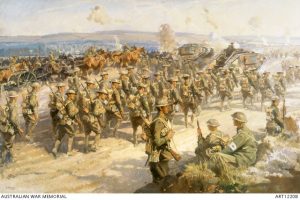
Between 15 July and 7th August six French armies, with American, British and Italian Army Corps, halted and turned back the last great German offensive. This was followed by the British led offensive at Amiens on 8th August – the black day of the German army.
From this time the Germans were on the back foot and under continuous pressure from the allies. The last 100 days of the war cost the British 360,000 casualties. About one quarter of the strength of the BEF. Only the 1916 battle of the Somme cost more.
3 The feats of arms of the British Forces of 1918 were one of the high points in British Military history
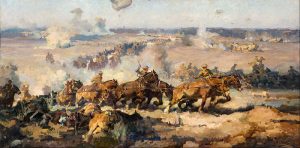
It isn’t fashionable to praise the First World War as an allied victory; or to admire its generals. But there is much merit in the performance of British and commonwealth armed forces on the Western Front in 1918.
The retreat from Mons by the BEF in 1914 is famous, but the fighting retreats of March and April 1918 were fought by an amateur citizen army which fought a series of continuous engagements instead of two battles and a series of skirmishes. According to the Official History the retreats of 1918 were a greater achievement.
Turning defeat into victory is a remarkable achievement. The BEF of 1918 lost twice as many casualties as the BEF in 1940, but then turned around and beat the Germans. The experience was unique and unlike the trench warfare that preceded it.
The British army of 1918 won the war. In the last 100 days it took almost as many prisoners as other allied armies put together. Its tactics were closer to 1940 than 1914. Its leaders, castigated as “butchers and bunglers” turned out to be good effective experienced commanders. The leadership and tactics in 1918 are hard to fault. At the end of the First World War the Britain’s Armed Forces were at a peak. They had mastered modern mechanised warfare. The Royal Air Force was the worlds largest, and only independent, air force, and had mastered most of the elements of air power. These were remarkable achievements for a citizen army.
4. The experience of 1918 was unique and deserves the same recognition extended to the Somme and Paschendaele.
There are qualitative differences in the solders’ experience, and in how we perceive them and the losses they suffered. The battles of 1916 were fought by citizen armies largely new to the fray and with a sense that they would deliver the big push that would end the war. There was a false dawn in 1917 with Vimy Ridge and Arras, but by Passchendaele the British and commonwealth armies had lost their sense of optimism. Their losses in retrospect have been seen as an almost biblical sacrifice. “what passing bell tolls for those who die like cattle?” -” I died in Hell men called it “Passchendaele.” The late Bob Bushaway wrote a perceptive paper on this elevation of the war dead from the casualties of war to sacrifices for mankind. Passchedaele epitomes loss and futility that is perhaps the mostly widely popular narrative of the First World War. That the war continued for another decisive year is an inconvenience for this interpretation, doubly so as British soldiers return to undertake operations in the national interest and end as victors not sacrifices. It is easy to understand the temptation to lose interest after Passchendaele.
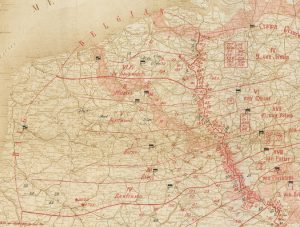
But that does not do justice to the story of the men who fought in 1918. The last hundred days was an unrelenting battle. Those who fought did not know that the war would end imminently. Many in authority thought it would continue to 1919 or 1920. Some of the soldiers’ letters refer to the thought that they had the Germans on the run and would try to finish them off before winter weather gave the Germans a respite. One striking feature of the graves of the men who fell in 1918 is the proportion with at least one decoration. These men had already done their bit but were determined to finish the job. Their knowing sacrifice deserves some focused reflection.
Places to evoke memories of 1918
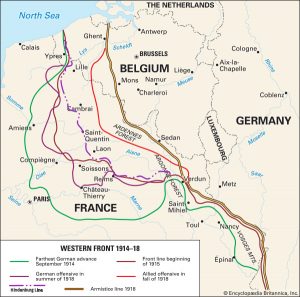 Battlefields are places of historic memory. Yes, they inform the visitor about how the micro-terrain influenced events, and the sights, sounds and smell of the landscape. They are also powerful symbols evoking memories and emotions. They have a deep cultural significance as places of sacrifice, reinforced by memorials and ceremony. The places dedicated to the sacrifices of 1916 and 1917 won’ t serve the memories of 1918. It is hard to think about successful open warfare at Amiens while standing at the Menin Gate, literally on the road to the mud of Passchendaele.
Battlefields are places of historic memory. Yes, they inform the visitor about how the micro-terrain influenced events, and the sights, sounds and smell of the landscape. They are also powerful symbols evoking memories and emotions. They have a deep cultural significance as places of sacrifice, reinforced by memorials and ceremony. The places dedicated to the sacrifices of 1916 and 1917 won’ t serve the memories of 1918. It is hard to think about successful open warfare at Amiens while standing at the Menin Gate, literally on the road to the mud of Passchendaele.
The Somme
In 1918 the fighting crossed the 1916 battlefields twice. But the 1918 battlefield covered a much wider area. To interpret the battle the visitor should explore the area around St Quentin. West of that town were the British lines that formed the setting for the play Journey’s End and the German onslaught in March. In late September the British with Australian and American troops forced their way across the Hindenburg line a few miles north of St Quentin. Peronne, ten miles to the west was the site of British rear-guard fighting in March and a great feat of arms by the Australian Corps in August. It also has a fine museum, the Péronne Museum of the Historial de la Grande Guerre, overlooked by many visitors to the 1916 battlefields. The graves dating from March and August 1918 are evidence of the fighting that took place across the old battlefield. The memorial to the Fifth Army missing of 1918 is in the Pozieres war cemetery on the road from Pozieres to la Boiselle – often ignored by visitors. The fighting extended west of Albert to Villers Bretonneaux outside Amiens, the site of Australian feats of arms and their national memorial in France. The graves of many British soldiers in Villers Bretonneaux is ample evidence of the part played by British troops in the area, which is also the location of the first battle between tanks.
There is no single memorial to the battle of Amiens. The paths of British and Commonwealth troops east can best be evidenced by the graves dated August 1918. The formidable Hindenburg line lay east of the March 1918 Allied lines. You can find remains of German defences and memorials to the battle that forced this line.
Flanders
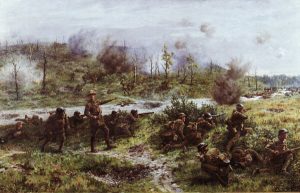
The second German offensive was in Flanders, in the area between Armentieres and La Bassee, stretching West as far as Hazebrouck and Mount Kemmel. Start with the Portuguese cemetery just south of the Indian Army memorial at Neuve Chapelle. Under equipped and under-trained the Portuguese defenders of this quiet sector were some of the unfortunate victims of the Germans Georgette offensive. The 55th Division memorial at Givenchy commemorates the gallant stand by the territorial soldiers from West Lancashire holding the flank of the German breakthrough. The German Alpine corps took Mont Kemmel, south west of Ieper, which then fought over by British and French troops for the next three months. Mount Kemmel is an overlooked battle. The French war cemetery with 5,000 graves testifies to the ferocity of the fighting. The US memorial at Vierstraat Kemmel is a reminder of the 60,000 American soldiers who served in the area in August 1918. On 27th September Ieper was the starting point for the last act in the Salient. A single day was all that was needed to capture the whole of Passchendaele Ridge. The fighting that followed half-way to Brussels was hard enough for several VCs to be awarded and for Brigadier Freyburg to be awarded two bars to his DSO. The Americans captured Oudenarde, and their Flanders Fields cemetery at Waregem has those that fell.
Arras to Le Cateau and Mons
Thousands of people visit the impressive memorial and preserved battlefield of Vimy Ridge, captured by the Canadian corps in 1917. Far, far fewer follow the story of the Canadian and British troops that advanced from Arras to Cambrai, Mons and Le Cateau. This was no triumphal parade. The memorial to the missing at Vis-en-Artois was the site of a bloody set back at the end of August, while at Iwuy in October the Germans counterattacked with tanks, throwing the British back.
The Aisne
British troops were also deployed to the Aisne area North East of Paris. In May an army corps of some 80,000 battered in the earlier German attacks was sent to a quiet sector to recover and integrate reinforcements. Unfortunately for them they were in the path of the next German offensive. The experiences of Captain Ulick Bernard Burke of the Devonshire Regiment were recorded and the digitised recording is held by the Imperial War Museum available . From 11 minutes into reel 17 he describes the last stand of the battalion.
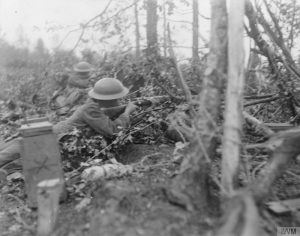
Further east, in July two divisions, some 35,000 soldiers fought under French command near Rheims, supported by American tanks and Italian artillery in the second battle of the Marne. From Paris eastwards the American Expeditionary Force (AEF) played a major role in halting the Germans and turning them back. The AEF battlefields of the Aisne-Marne, Champagne, Meuse-Argonne and St Mihel are well preserved and interpreted. If you are interested in visiting these, check out americanvictory.com
There is far more to the fighting in 1918 than the 100 days as a prelude to the Armistice. It is a shame that there is so little public awareness or interest in public education by the bodies that should take the lead.
If you are interested in visiting the battlefields of 1918 contact info@baldwinbattlefieldtours.com
